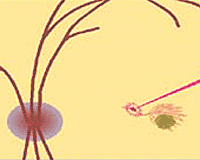High-speed photography may identify CNV feeder vessels
Patients have regained vision within hours of laser treatment for the vessels.
TOWSON, Md. — High-speed indocyanine green (ICG) angiography can identify feeder vessels, and microlasering them can lead to visual acuity improvement in a matter of hours, said Bert Glaser, MD, of the Glaser Murphy Retina Treatment Center.
Occult choroidal neovascularization (CNV) is difficult to treat due to the uncertainty of its border, as seen with fluorescein angiography. The feeder vessels have small diameters and long lengths, typically between 500 µm and 1,500 µm.
Robert Flower, MD, of the Glaser Murphy Retina Treatment Center, developed the high-speed angiography technique, which also is called Phi-motion angiography. The name stems from the general term for using high-speed photography to capture images in rapidly changing environments.
In ophthalmology, the technique applies a scanning laser to acquire rapid sequence images that illustrate the blood vessels underlying the retina.
Dr. Glaser has spent the past 2 years evaluating and treating more than 300 cases of subfoveal CNV using high-speed ICG angiography and microlaser treatment of feeder vessels.
“As part of this experience, we have observed a dramatic response to many patients with occult CNV,” he said.
Outcome measures
 ---Pinpoint laser treatment to extrafoveal portion of feeder vessel.
---Pinpoint laser treatment to extrafoveal portion of feeder vessel.
COURTESY OF BERT GLASER, MD, and ROBERT MURPHY, MD.
At the retinal subspecialty day of the American Academy of Ophthalmology meeting, Dr. Glaser presented results of the treatment of feeder vessels in 37 consecutive patients with subfoveal occult CNV.
Researchers conducted a prospective evaluation of patients with occult CNV. They viewed all eyes with biomicroscopy, fluorescein angiography and high-speed ICG angiography. Researchers treat patients with an 810 nm diode laser. They also enhanced ICG images to identify feeder vessels. If the feeder vessel was still present, it was treated immediately. They assessed visual acuity by ETDRS standards.
Researchers created two-dimensional maps of the choroidal vasculature and paid attention to the early part of the angiogram. They measured and characterized the length and diameter of each vessel.
Main outcome measures included closure of the feeder vessel on high-speed ICG, improved visual acuity and decreased subretinal fluid seen clinically, as well as on fluorescein and high-speed ICG.
Once they made a successful diagnosis, researchers examined the surrounding vessels for increased perfusion secondary to shunting blood away from the treated vessel.
In the study, 84% of the eyes achieved closure of feeder vessels. The number of treatments ranged from one to four, with an average of 1.6. The recurrence rate was 27% over 6 months, and vision improved one line in 78% and two lines in 43%.
Sharing results
 ---Cross section shows pinpoint laser of feeder vessel.
---Cross section shows pinpoint laser of feeder vessel.
COURTESY OF BERT GLASER, MD, and ROBERT MURPHY, MD.
Patients typically achieved visual acuity results of better than 20/63. The time to improvement was remarkably quick and was accomplished in 20 hours in one patient, Dr. Glaser said. Closure of the modulating vessel was successful in one treatment in some patients, but the majority needed more than one treatment. In a few cases, the vessel did not seal.
“The ability of feeder vessel treatment to resolve occult CNV may potentially expand our therapeutic reach,” Dr. Glaser said. “We sincerely hope that the task of teasing out the intricacies of the choroidal circulation will enhance our current technologies.”
He added that identifying feeder vessels with high-speed angiography involves a learning curve, and physicians will benefit from collaboration among as many investigators as possible. Dr. Glaser said he plans to publish results and share the protocols with any physician interested in pursuing this technology.
For Your Information:
- Bert Glaser, MD, can be reached at the Glaser Murphy Retina Treatment Center, 901 Dulaney Valley Road, Ste. 200, Towson, MD 21204; (410) 337-4500; fax: (410) 339-7326. Dr. Glaser has no direct financial interest in any of the products mentioned in this article, nor is he a paid consultant for any companies mentioned.
